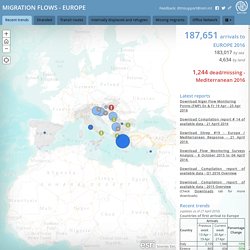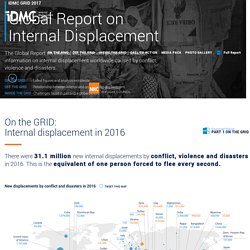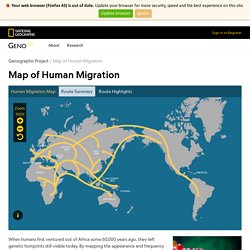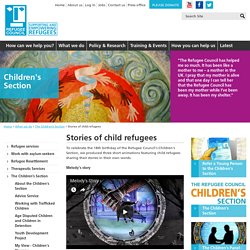

MIGRATION FLOWS - EUROPE. DISCLAIMER: Base Map Source: ESRI.

This map is for illustration purposes only. Names and boundaries on this map do not imply official endorsement or acceptance by IOM. ــــــــــــــــــــــــــــــــــــــــــــــــــــــــــــــــــــــــــــــــــــــــــــــــــــــــــــــــــــــــــــــــــــــــــــــــــــــــــــــــــــ Since January 2016, 187,651 people were reported to be arriving to Europe, by land and sea. In 2015, 1,046,599 people were reported to be arriving to Europe, by land and sea. The green circles indicate the number and country of origin for people that were reported as arriving in Europe since earlier this year.
Click on the green circles for more information. (Source: national authorities, IOM) For 2014, the Internal Displacement Monitoring Center (IDMC) reported that 57.3 million people around the world have been forced to flee their homes by armed conflict, generalized violence and natural disasters, while staying within their countries. (Source: IDMC) 2017 Report on Internal Displacement. In 2016, conflict and violence displaced more people in Sub-Saharan Africa than in the Middle East, according to a report released today by the Internal Displacement Monitoring Centre (IDMC) and the Norwegian Refugee Council (NRC).

Of the 6.9 million new internal displacements by conflict in 2016, 2.6 million took place in Sub-Saharan Africa, and 2.1 million in the Middle East and North Africa, according to the Global Report on Internal Displacement. Infographic: asylum applications in the EU. Catalanfootprintinaustralia. 100 Images of Migration gallery. ‘He was just a kid’: the boy who became a symbol of Spain's migration crisis. Among the immaculately tended, flower-bedecked graves of Barbate cemetery, one tomb stands out.

Its occupant was not from the Andalusian town – he was not even Spanish – and his gravestone is decorated not with an image of Christ or the Virgin Mary but a picture of waves breaking on a sandy beach and a photograph of a little boy wrapped up in a scarf and coat. “God has given and God has taken away,” reads the epitaph in French. “Blessed be God.” Here, surrounded by the dead of a country he never knew, lies Samuel Kabamba, a four-year-old from the Democratic Republic of the Congo who died trying to reach Europe with his mother, Véronique Nzazi.
A year ago this Saturday, his body washed up on a beach near Cape Trafalgar, a few miles from Barbate. Statistics from the International Organisation for Migration (IOM) showed that 21,468 migrants and refugees arrived in Spain by sea in 2017, with 223 people – including Samuel and his mother – dying as they made the journey. Carte migrants pays origine 2018_UNHCR. Carte igrants par pays accueil 2018 UNHCR. Carte conflits 2017 déplacements intérieurs - UNHCR. Map of Human Migration. When humans first ventured out of Africa some 60,000 years ago, they left genetic footprints still visible today.

By mapping the appearance and frequency of genetic markers in modern peoples, we create a picture of when and where ancient humans moved around the world. These great migrations eventually led the descendants of a small group of Africans to occupy even the farthest reaches of the Earth. Our species is an African one: Africa is where we first evolved, and where we have spent the majority of our time on Earth. The earliest fossils of recognizably modern Homo sapiens appear in the fossil record at Omo Kibish in Ethiopia, around 200,000 years ago. Although earlier fossils may be found over the coming years, this is our best understanding of when and approximately where we originated.
According to the genetic and paleontological record, we only started to leave Africa between 60,000 and 70,000 years ago. The story doesn’t end there, of course. Stories of Separated Children - Child Refugees - Refugee Council. To celebrate the 18th birthday of the Refugee Council's Children's Section, we produced three short animations featuring child refugees sharing their stories in their own words.

Melody's story In this animation, Melody tells her story of arriving in the UK completely alone at the age of 12. She was sent to the UK from her home country of Nigeria to live with a friend of the family, but was forced to live in domestic servitude and was repeatedly beaten and sexually abused. To find out more about our vital work protecting child refugees like Melody, please visit this page. Matiullah's story In this short film, Matiullah shares his reason for fleeing the Taliban in Afghanistan when he was only 15 years old, and what he went through during his 3-month long, treacherous journey to the UK.
Matiullah is currently a volunteer for the Refugee Council and was recently presented with an award by Muhammad Ali and David Beckham for his work in the community. Faisal's story.